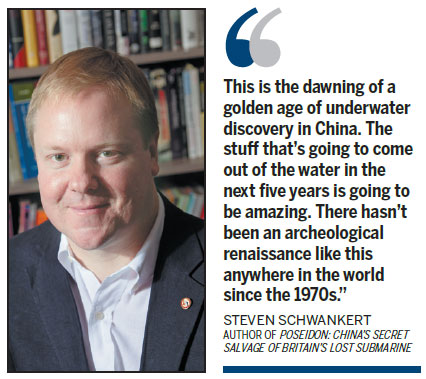Submarine saga surfaces at lit festival
By Matt Hodges ( China Daily ) Updated: 2014-03-25 09:31:00
The findings could rewrite history. "My guess is that local trade routes all go back way longer than we've estimated. It's only a matter of time before we find an Arabian or African ship in the South China Sea," says Schwankert, an entertaining orator and meticulous researcher with a penchant for wearing his wristwatch back to front, as divers often do with their depth gauges.
"That will happen, and I think people will be surprised at the number of discoveries made," he adds.
The South China Sea contains a treasure trove of wrecks for divers to explore, with highlights including Britain's HMS Repulse and HMS Prince of Wales. But it is an Italian liner at the bottom of the North Atlantic, the Andrea Doria, which sank just south of Nantucket, Massachusetts in 1956, that has been dubbed "the Everest of diving" at 70 meters down. Alvin Moscow's book Collision Course explains its tragic story in detail.
Schwankert says China can expect to salvage hordes of unspoiled pottery, porcelain, jewelry and silver from the Tang (AD 618-907) to Qing (1644-1911) dynasties, "but probably not much gold".
"It will probably be very different from the Pirates of the Caribbean stuff coming out of America - no treasure chests or pieces-of-eight - but no less interesting," he says.
"I hope I can play just a teeny, tiny role in China's rediscovery of its recent maritime heritage," adds the New Jersey native, who believes such foraging can be used to shore up China's territorial claims.
President Xi Jinping called on ASEAN members to cooperate on building a new "maritime silk road" during his first official swing through Southeast Asia last October. He issued the remarks in Indonesia amid a climate of simmering territorial disputes in Asia, notably between China and Japan over the Diaoyu Islands in the East China Sea.
"We're tightly following the 12th Five-Year Plan to carry out underwater archeology work regularly to protect China's heritage and reclaim its maritime history," says Jiang Bo, a director at the State Administration of Cultural Heritage Center for Underwater Cultural Heritage in Beijing.
In 2013, the center successfully ferried the Nanhai 1, a Song Dynasty (960-1279) vessel, to the Guangdong Maritime Silk Road Museum for storage. Raised from the ocean floor south of the province in 2007, it ranks as the largest sunken cargo vessel discovered in Chinese waters to date.
China also reopened the Baihe - liang Underwater Museum at 40 meters below sea level in 2012 to protect a reef in the Yangtze River near Chongqing and is now at work on a next-generation underwater exploration boat, Jiang says.
It was Schwankert's passion for diving that led him to stumble upon the Poseidon story. He led the first scientific expedition to dive Mongolia's Lake Khovsgol in 2007, where his team found two wooden shipwrecks dating back to the early 20th century.
He says China offers "wonderful" opportunities for divers, despite its paucity of tropical marine life and its chilly underwater climes. Highlights include a 1,000-year-old city submerged in Zhejiang's Qiandaohu (Thousand-island lake) and parts of the Great Wall.
"The best thing diving in China offers is history," he says. "You can't dive the (Egyptian) pyramids, but you can dive the Great Wall, and it's a much more intimate experience than hiking it. You're not focused on the horizon, you look at the craftsmanship. And you get a 360-degree view - you can be on top of it, next to it, and sometimes even underneath it."
When asked whether China's underwater-salvaging skills and technology could play a role in helping or retrieve Malaysian Airlines flight MH370, he would not be drawn.
But Schwankert used the story of the Nanhai 1 to illustrate how the nation is experimenting with novel approaches in this field.
"They used what I call the Siberian woolly mammoth technique to keep it structurally intact," he says with a trademark quip, adding that the team carved the frozen wreck into four-ton blocks of ice and ferried them inland to sit in a pool of water in southern China.
He is working on another missing piece of history involving a sunken ship off China's coast for his next book.
|
|
|
|
|
|
|
|























 Raymond Zhou:
Raymond Zhou: Pauline D Loh:
Pauline D Loh: Hot Pot
Hot Pot Eco China
Eco China China Dream
China Dream China Face
China Face





